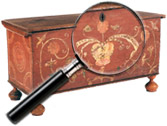|
|
William Matthew Prior (1806 to 1873)
In the decades just before the advent of photography, a solid middle class began to form in America, a middle class that sought to aspire to and attempt to replicate some of the finer things of the upper class. Portraits were some of the most visible and sentimental of these objects, and as a result, portrait painters (or limners, as they were sometimes called) began to flock to [...] Click here to continue reading.
Panoramic Views
Accurately rendering a panoramic view has long challenged, obsessed and inspired artists. The trend seems to have sprung up in the 17th century, with works that served both as slightly more helpful, more detailed maps with various public or important buildings marked, but also as advertisements for towns and cities. Matthaeus Merian, a Swiss engraver who spent most of his career in Frankfurt, where he also ran a publishing house passed to [...] Click here to continue reading.
Coca-Cola
Dr. John Stith Pemberton (1831 to 1888), an Atlanta pharmacist, invented Coca-Cola in 1886. A year earlier, he had introduced an alcoholic beverage called “Pemberton’s French wine coca”, but the temperance movement was then gathering momentum in the United States, prompting him to develop an alcohol-free product. Pemberton mixed a combination of lime, cinnamon, coca leaves, and kola nuts to make the famous beverage. When Coca-Cola was first introduced, the syrup was mixed [...] Click here to continue reading.
James Butler “Wild Bill” Hickok
Unlike the Hollywood nice guy from 1950′s television, the real Wild Bill Hickok was a born killer and compulsive gambler.
Between his birth as James Butler Hickok in 1837 and his 1876 death, Hickok defined the fiercely independent Wild West peacekeeper that never stayed long in one place. Raised to anti-slavery parents in Illinois, Hickok developed a strong sense of loyalty and duty that lasted his entire life. [...] Click here to continue reading.
Newcomb College Art Pottery
Before it was revered for its art, and more specifically for its art pottery, Newcomb College was the country’s first degree-granting college for women within a major university. Its founder, Josephine L. Newcomb, envisioned an environment in which women would learn both practical skills and academic knowledge when she proposed the creation of the college in the memory of her daughter H. Sophie Newcomb, who died at 15. New Orleans’s [...] Click here to continue reading.
photograph of Grandma Moses, photograph by Rudolph Rissland (p4A item E8981620) Anna Mary Robertson Moses ‘Grandma Moses’ (1860-1961)
Anna Mary Robertson, more commonly known as Grandma Moses, was born in 1860 in Greenwich, New York. She grew up in a large family, where the girls were taught how to perform a variety of domestic tasks. After she married Thomas Salmon Moses, Grandma Moses spent nearly 20 years raising her children on their farm. [...] Click here to continue reading.
Vermeil
“Vermeil” is a French word co-opted by the English in the 19th century for a silver gilt process. Vermeil is a combination of silver and gold, although other precious metals are also occasionally added, that is then gilded onto a sterling silver object. The reddish (vermilion) hue of the addition of the gold gives the product its name. Vermeil is commonly found in jewelry, and a standard of quality (10 karat gold) and [...] Click here to continue reading.
Wilbur G. Adam (1898-1973)
A Cincinnati native and a decorated artist during his career, Wilbur Adam’s work has rarely surfaced on the market and has fallen into obscurity in recent years.
Collectors intimately familiar with the early 20th century school of Cincinnati artists might be surprised at Adam’s work and his association with many of the Queen City’s notables- including Frank Duveneck, Herman and Bessie Wessel, Lewis Henry Meakin, and Caroline Lord, to [...] Click here to continue reading.
Joan Miro (Spanish, 1893-1983) Joan Miro lithograph, Signes Et Meteores, printed in colors, 1958, p4A item E8972489
Joan Miro was born in Barcelona, Spain, on April 20, 1893, the son of a watchmaker. From 1912 he studied at the Barcelona Ecole des Beaux-Arts and the Academie Gali. In the first quarter of the 20th century, Barcelona was a cosmopolitan, intellectual city with a craving for the new in art, music, and literature. But, it [...] Click here to continue reading.
Frederick Maxfield Parrish (1870 to 1966)
Frederick Maxfield Parrish was born July 25, 1870 in Philadelphia to Stephen Parrish, an American artist famous for his landscapes, illustrations and engravings and his wife Elizabeth Bancroft Parrish. It’s not surprising that, finding himself surrounded by the tools of his father’s trade, that Frederick (he would begin to use Maxfield as his name later in life) would begin to draw to amuse himself. Around 1881, the Parrish [...] Click here to continue reading.
|
Recent Articles
- Charles Alfred Meurer – American Artist & Tromp L’Oeil Artist
- Sendak, Maurice – American Artist & Writer
- Godie, Lee – American Artist
- Davis, Vestie – American Artist
- Bartlett, Morton – American Artist
- Mackintosh, Dwight – American Artist
- Evans, Minnie Jones – African-American Artist
- Mumma, Ed (Mr. Eddy) – American Artist
- Nice, Don – American Artist
- Savitsky, John (Jack) – American Artist
- Gordon, Harold Theodore (Ted) – American Artist
- Dial, Thornton – African-American Artist
- Doyle Sam – American Artist
- Johnson, Lester Frederick – American Artist
- Finster, Howard – American Artist
|
|
